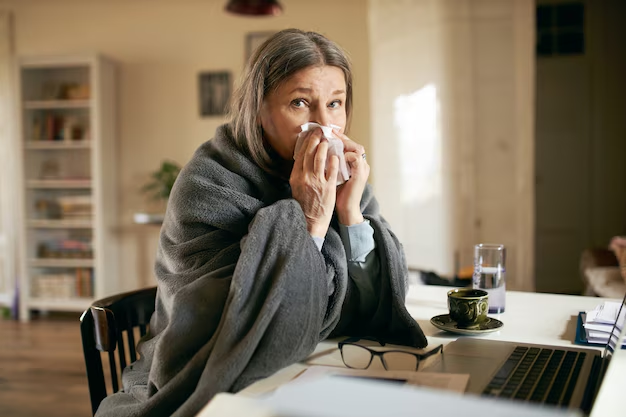Can You Have Pneumonia Without a Fever? Understanding Atypical Pneumonia Symptoms
When we think about pneumonia, the image that typically comes to mind is one of someone bedridden with a high fever, coughing incessantly. But what if you could have pneumonia without experiencing a fever? Understandably, this possibility can be confusing and alarming. It raises essential questions about identifying pneumonia, particularly when its symptoms don't align with our expectations.
Understanding Pneumonia: The Basics
Before diving into the nuances of pneumonia without fever, it's crucial to understand what pneumonia is. Pneumonia is an infection that inflames the air sacs (alveoli) in one or both lungs. These air sacs may fill with fluid or pus, leading to symptoms that can range from mild to severe.
Common Causes of Pneumonia
Pneumonia can be caused by a variety of agents:
- Bacteria: The most common bacterial culprits include Streptococcus pneumoniae and Mycoplasma pneumoniae, among others.
- Viruses: Some pneumonia cases are caused by viruses such as respiratory syncytial virus (RSV) and even influenza (flu).
- Fungi: More rarely, fungi like Histoplasma can cause pneumonia, especially in immunocompromised individuals.
Typical Symptoms of Pneumonia
Most people associate pneumonia with:
- High fever and chills
- Persistent cough, often with phlegm
- Shortness of breath
- Chest pain when breathing or coughing
These symptoms make it clear why pneumonia is often equated with severe colds or flu-like illnesses.
Atypical Pneumonia: When Fever Isn't Present
What is Atypical Pneumonia?
Atypical pneumonia, sometimes known as "walking pneumonia," differs from the norm. It’s often milder but can still disrupt daily activities significantly. Notably, it may not present with a fever, making it harder to diagnose.
Causes of Atypical Pneumonia
Several pathogens are responsible for atypical pneumonia. These include:
- Mycoplasma pneumoniae: Frequently affects younger individuals and might not cause fever.
- Chlamydophila pneumoniae: Another bacterium linked with mild, often feverless symptoms.
- Legionella pneumophila: Known for causing Legionnaires' disease, which can occur without fever.
Symptoms Beyond Fever
When fever isn't present, look for other signs:
- Persistent dry cough
- Fatigue and general malaise
- Headaches or body aches
- Sore throat
These symptoms, while less pronounced, can still suggest pneumonia and warrant further investigation.
Who Is at Risk for Pneumonia Without Fever?
Older Adults and Immunocompromised Individuals
Older adults and those with weakened immune systems are more likely to experience pneumonia without a fever. Their immune responses may not be strong enough to present typical symptoms, such as fever, which can lead to underdiagnosis or misdiagnosis.
Children
In some cases, children might also have pneumonia without a high fever, especially if it's caused by atypical bacteria. Symptoms might overlap with those of common childhood infections, complicating diagnosis.
Diagnosing Pneumonia Without Traditional Symptoms
Clinical Examinations and History
A healthcare provider will typically begin with a thorough clinical examination and medical history review. They'll consider factors such as:
- Recent respiratory infections
- Exposure to respiratory pathogens
- Overall health and immune status
Diagnostic Tests
To confirm pneumonia, doctors may use:
- Chest X-rays: These can reveal lung inflammation and are pivotal in diagnosing pneumonia.
- Blood tests: These assess the body's response to potential infections.
- Sputum culture: This helps identify the causative agent in bacterial pneumonia.
When fever is absent, these tests become vital in diagnosing what's frequently an overlooked illness.
Treatment and Management
Antibiotics for Bacterial Causes
If bacteria are to blame, antibiotics can treat most cases of pneumonia. However, note that antibiotics won't help viral pneumonia.
Supportive Care
Whether fever is present or not, care strategies remain similar:
- Rest and hydration: Essential for recovery and symptom management.
- Pain relievers: Though they don't reduce fever, they can alleviate other symptoms like aches and chest pain.
Hospitalization
In severe cases, especially among the elderly or those with compromised systems, hospitalization might be necessary to ensure adequate oxygenation and hydration.
Practical Steps If You Suspect Pneumonia Without a Fever
- Seek Medical Attention: If you suspect you have pneumonia, contact a healthcare provider, especially if symptoms persist or worsen.
- Monitor Symptoms: Track any symptoms and their progression meticulously.
- Follow Medical Advice: Ensure adherence to prescribed treatment plans.
The Broader Implications of Pneumonia
Public Health Perspective
Understanding that pneumonia can occur without fever has broad implications for public health. It emphasizes the need for:
- Increased Awareness: More education around atypical symptoms can aid in quicker diagnosis and treatment.
- Vigilant Monitoring: Health systems should encourage diligent observation beyond traditional symptoms.
Prevention
Preventive measures, while unable to guarantee immunity, can reduce the risk of infection:
- Vaccinations: Pneumococcal vaccines can prevent certain bacterial causes of pneumonia.
- Good Hygiene: Regular handwashing and wearing masks during flu season can lower respiratory infection risk.
Resilience Building
Finally, fostering general health through balanced nutrition, exercise, and managing chronic conditions can strengthen resilience to infections like pneumonia.
In understanding pneumonia without a fever, we appreciate the complexity of the human body. It underscores the importance of comprehensive medical analysis and nuanced understanding in identifying illnesses, even when they don't fit neatly into common symptom profiles.
Quick Tips: Identifying and Managing Pneumonia without Fever 🌟
- Watch for Non-Fever Symptoms 📋: Persistent cough, fatigue, headaches.
- At-Risk Groups 🚨: Be extra vigilant if you're older, immunocompromised, or caring for these populations.
- Consult Healthcare Providers 👩⚕️: Seek professional advice with persistent respiratory issues.
- Utilize Diagnostic Tools 🩺: Chest X-rays and other tests can reveal pneumonia even without fever.
- Prioritize Preventive Measures 🛡️: Vaccinations and hygiene habits to mitigate risks.

Related Articles
- a Typical Pneumonia
- Can a Cold Turn Into Pneumonia
- Can a Sinus Infection Turn Into Pneumonia
- Can Amoxicillin Cure Pneumonia
- Can Amoxicillin Treat Pneumonia
- Can Baby Oil Cause Pneumonia
- Can Bronchitis Turn Into Pneumonia
- Can Covid Turn Into Pneumonia
- Can Doxycycline Treat Pneumonia
- Can Flu Turn Into Pneumonia